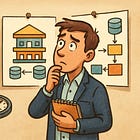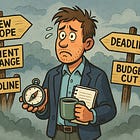Why Every Consultant Should Learn to Draw (Even Badly) 🎨
Why visual thinking is one of the most underrated consulting skills—and how to start even if you “can’t draw"
I have terrible handwriting. I’ve never been good at sketching either. But I still draw almost every day—especially at work.
And no, it’s not only because I’m an enterprise architect or because it’s “part of my job.” I draw because it helps me and others think.
Not to impress anyone with artistic skill (trust me, no one would be impressed),
but because drawing is thinking made visible.
And in consulting, that’s one of the most underrated skills you can have.
Why Drawing Matters in Consulting
Consulting is about bringing clarity to complexity. And nothing clarifies faster than a good sketch.
A simple drawing—boxes and arrows—does three magical things at once:
It forces you to simplify. You can’t draw confusion. You can only draw what you understand.
It creates alignment. When everyone looks at the same picture, gaps and misunderstandings surface instantly.
It makes invisible work visible—processes, relationships, dependencies, decisions.
That’s why the best consultants aren’t just talkers or writers. They’re visual thinkers. They know that a napkin sketch can sometimes do more than a 40-slide deck. Because a drawing doesn’t just communicate—it builds credibility.
When you draw, you’re showing your thinking in real time. You’re saying:
“I understand this well enough to make it simple.” A visual sketch also gives clients and teammates something tangible to react to, something they can discuss, adjust, and agree on. It turns abstract talk into shared understanding. And people trust what they can see.
A consultant who draws signals confidence—not in art, but in clarity.
“But I Can’t Draw!”
You don’t need to. You’re not making art, you’re making sense. In consulting, drawings are functional, not decorative.
If you can draw:
a box for an application,
an arrow for a relationship,
and a stick figure for a person,
…you already have everything you need.
Digital whiteboards or PowerPoints are enough. I personally sketch on my laptop using a modeling tool or generic office software—partly because my handwriting is unreadable, and partly because it’s fast and shareable. The point isn’t aesthetics. The point is clarity.
When to Draw
There are moments when words just won’t cut it. These are your cues to start sketching:
When a discussion loops endlessly. “Wait, are we talking about the same thing?” A quick visual ends circular debates faster than thirty more minutes of talking.
When things get complex. If you’re describing multiple applications, stakeholders, or processes, the human brain just can’t hold it all in words. A simple diagram instantly makes it manageable.
When you need to show flow. Processes, decisions, or data streams—anything that moves through time or steps—begs to be drawn.
When different teams describe the same thing differently. Visuals create shared language and surface hidden assumptions.
When you’re structuring your own thinking. Before jumping into slides or documents, a rough sketch helps you see what fits, and what doesn’t.
When alignment feels fuzzy. Even a quick “so this is what I’m hearing” drawing can reveal gaps in understanding before they grow into problems.
If you catch yourself talking with your hands, you probably should’ve been drawing five minutes ago.
What to Draw
You don’t need to invent new models. Just visualize what’s already in your (or someone else’s) head. Here are some everyday consulting sketches that work wonders:
Process blueprints: What happens, in what order, and who’s responsible.
Application landscapes: What software tools and applications talk to which.
Stakeholder maps: Who’s influencing whom.
Information flow diagrams: Where data moves (and where it gets stuck).
Decision trees: Options, trade-offs, and outcomes.
Journey maps: How users or customers experience a process.
Once you start drawing, you’ll notice how much faster people “get it.”
Drawing in Consulting: Dos and Don’ts
Even drawing can go wrong. Here’s how not to do it and what to do instead:
❌ Over-polishing diagrams. Spending hours aligning boxes defeats the purpose. The best sketches are quick, iterative, and disposable. The goal is insight, not artwork.
❌ Hiding behind jargon or technology. Fancy icons or tool-generated visuals don’t make a concept clearer. Simple shapes and plain language do.
❌ Drawing too late. If you only visualize at the end, you miss the chance to uncover misunderstandings early. Draw as you think, not after you’ve thought.
❌ Unclear visuals. Every box, arrow, and label should have a clear meaning. If you can’t explain what something represents, neither can your audience.
❌ Overloaded diagrams. When a single picture tries to show everything, it communicates nothing. Split complex topics into multiple focused views.
✅ Do use light structure. In complex contexts, a simple notation or consistent color scheme can make your drawings far easier to read. (Architecture frameworks use this for a reason.)
✅ Do add context. Some visuals need a short verbal or written explanation. A 20-second walkthrough can turn confusion into shared understanding.
✅ Do keep diagrams alive. Update them as the project evolves. The drawing isn’t the deliverable, the conversation it enables is.
The Hidden Benefit: Thinking Like an Architect
Drawing is also the first step toward architectural thinking.
When you map processes, applications, or data flows, you’re already doing the same kind of reasoning enterprise architects do—just at a smaller scale.
It’s how you start seeing connections, dependencies, and ripple effects. It’s how you make decisions that fit the whole picture, not just your task.
If you’re curious about going deeper, I’ve written more about architecture thinking in my sister publication, Enterprise Architecture Transformation.
Final Thoughts
You don’t need to be an artist to think like one. A whiteboard marker or a digital pen is one of the most powerful consulting tools you can have.
So next time you’re tempted to explain something complicated with 10 slides or 500 words, try one drawing instead.
It might be ugly. But it’ll be clear. And that’s what clients remember.
See you next time,
Eetu Niemi
IT Consulting Career Hub 🚀
📚 Related Reads from the IT Consulting Career Hub
If this topic resonated with you, you might also enjoy:





